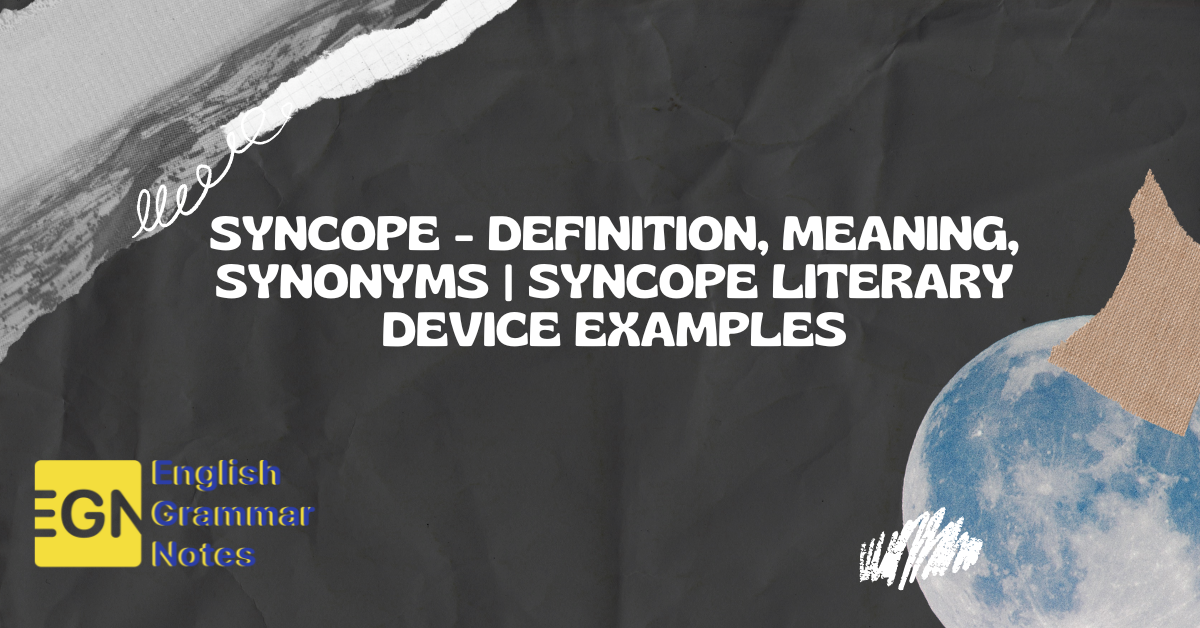You might have often heard of the term Syncope and wondered what it means. Syncope is one of the commonly used literary devices. Syncope comes from the Greek combination ‘syn’ and ‘koptein’, which means “to strike off,” or “cut from the middest”. In this article, you will be introduced to all the essential information about syncope including its definition, examples, function etc.
- What is Syncope?
- Syncope Examples
- Function of Syncope
- What is Syncope?
- Give some examples of syncope?
- What is the function of syncope?
What is Syncope?
Syncope, pronounced as, sing·kuh·pee, is a literary device that engages in the contraction or the shortening of a word. Syncope omits sounds, syllables or letters usually from the middle of the word. The sounds that are omitted are usually unstressed sounds. a letter or syllable that has been dropped will be replaced with an apostrophe.
Syncope Examples
Given below are some examples of syncope seen in everyday conversations:
- camera- the sound ‘e’ is dropped and pronounced as cam’ra.
- chocolate- the sound ‘o’ is left out and pronounced as choc’late.
- restaurant- ‘au’ sound is dropped and pronounced as rest’rant.
- comparable- ‘a’ sound is removed and the word becomes compar’ble
- Family- ‘i’ sound is removed and the word is pronounced as fam’ly.
- Vegetable- ‘e’ sound is removed to pronounce the word as veg’table.
- Library- ‘a’ sound is removed and word becomes more like lib’ry.
- Madam- ‘d’ is dropped to sound more like ma’am.
- Buttoning- ‘o’ sound is dropped and the word becomes more like butt’ning

Read More:
Function of Syncope
The uses of Syncope include the following
- Syncope can be used to speed up conversations
- To balance the rhythmical pattern.
- Creates an artistic effect in readers’ mind.
Here is the Guide to English Grammar Notes & Study Material for grammar concepts that aid students ranging from beginner to advanced levels to score well.
FAQs on Syncope
Syncope, pronounced as, sing·kuh·pee, is a literary device that engages in the contraction or the shortening of a word. Syncope omits sounds, syllables, or letters usually from the middle of the word.
2. Give some examples of syncope?
Some examples of syncope include
- comparable- ‘a’ sound is removed.
- Family- ‘i’ sound is removed and the word is pronounced as famly.
- Vegetable- ‘e’ sound is removed to pronounce the word as vegtable.
3. What is the function of syncope?
Syncope has various functions: these include. As a rhetorical device syncope is often used to speed up conversations. Syncope is also used to bring about a rhythmical pattern and create an artistic effect in the reader’s mind.
Conclusion
Syncope is a commonly used literary device. The omission of a specific sound or syllable makes the word more informal. As a literary device, syncope helps you to make your poetry more rhythmic and to enhance the artistic effect on the reader. The use of syncope will help you to structure poems and prose in a unique manner.
